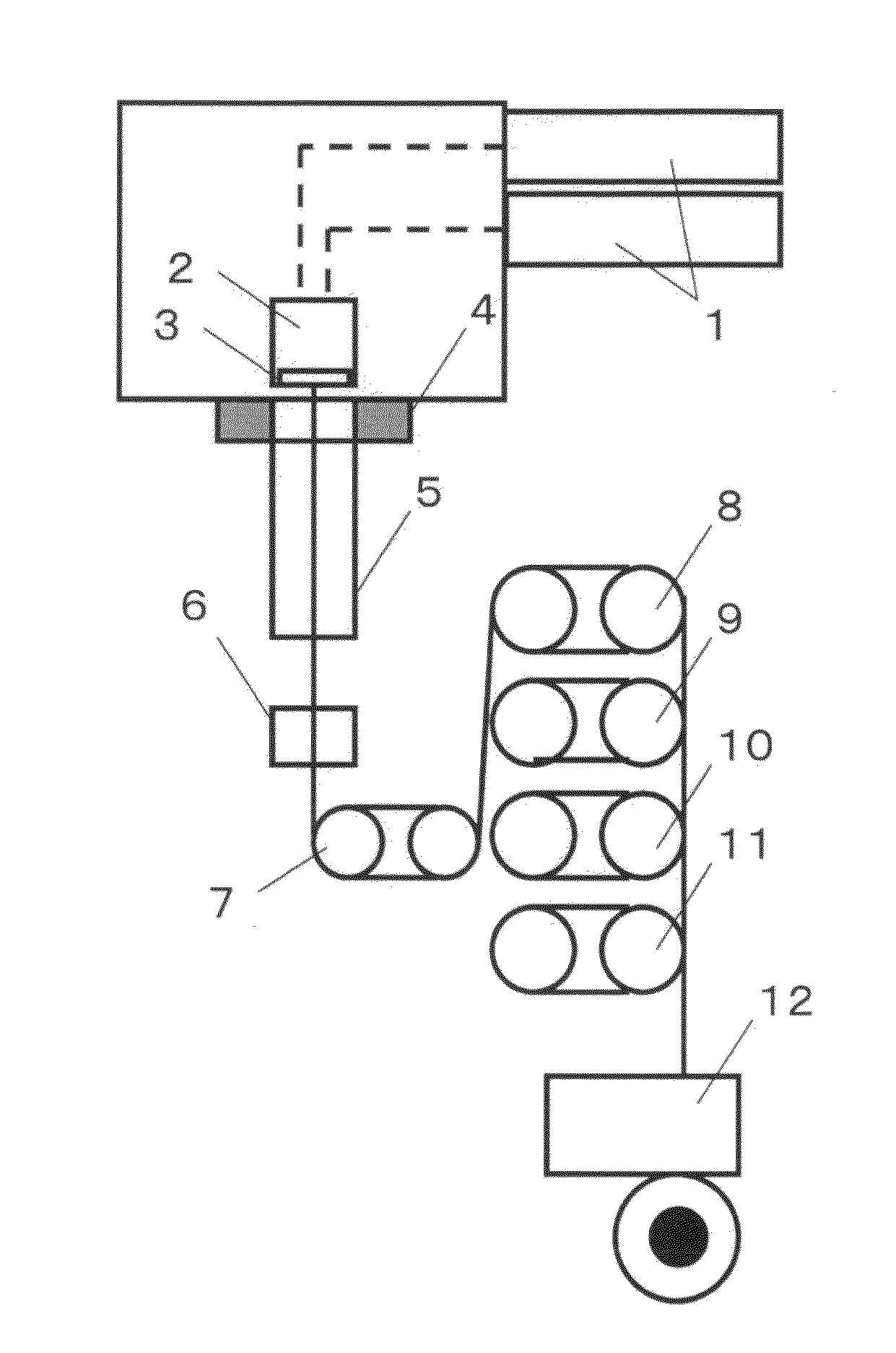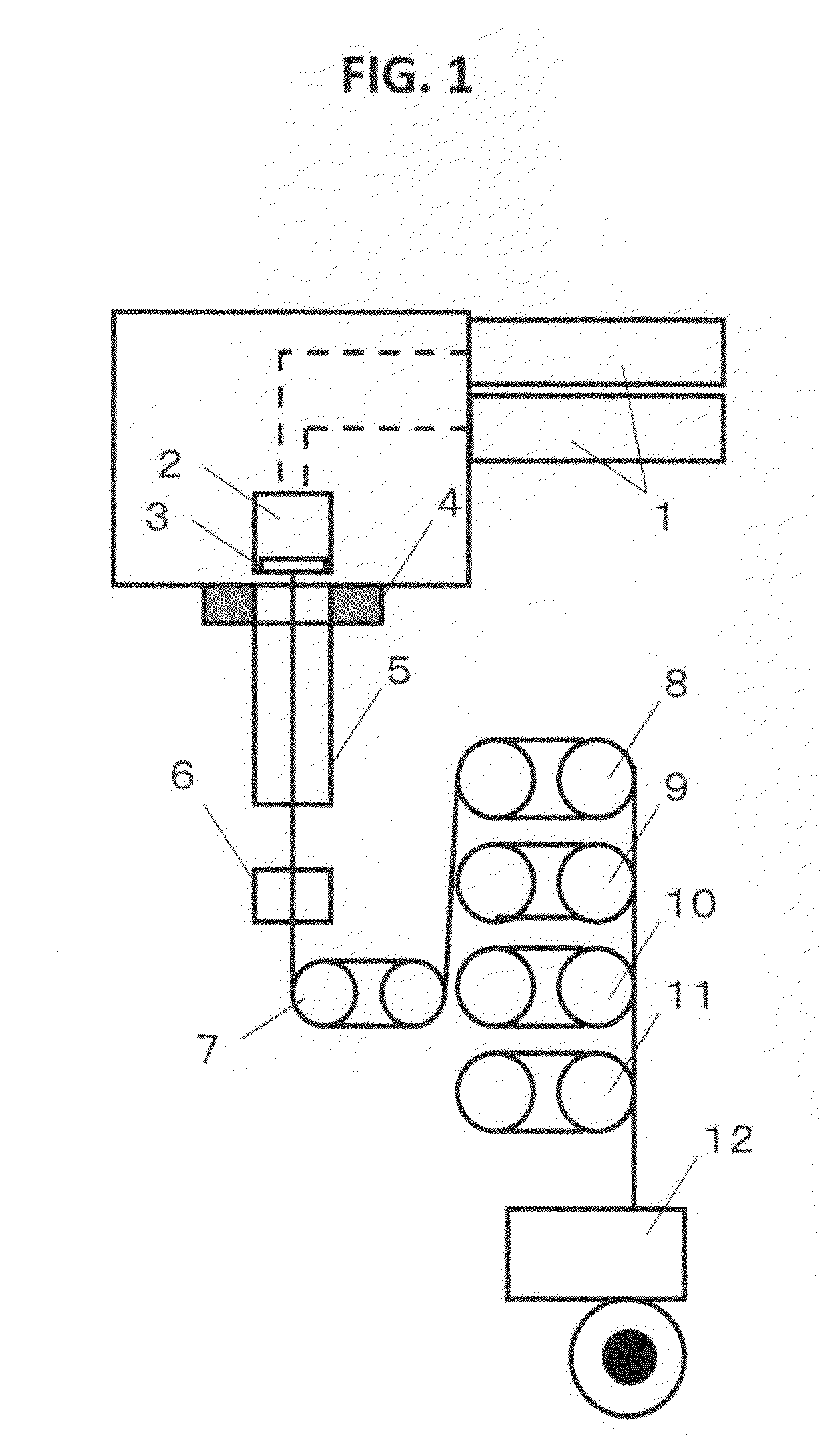Polyester monofilament, method for producing same, and method for producing screen gauze using same
a polyester monofilament and monofilament technology, applied in knitting, weaving, other domestic articles, etc., can solve the problems of easy breakage of yarn, difficult to stably produce high mesh density screen mesh cloth of 400 mesh or larger with this polyester monofilament, and unsuitable for obtaining high mesh density screen mesh cloth of 400 mesh or larger. , to achieve the effect of high mesh density, high mesh density, and uniform fiber diameter
- Summary
- Abstract
- Description
- Claims
- Application Information
AI Technical Summary
Benefits of technology
Problems solved by technology
Method used
Image
Examples
example 1
[0086]PET which was polymerized and pelletized by a conventional method and has an intrinsic viscosity (IV) of 1.15, and PET which has an intrinsic viscosity (IV) of 0.63 and contains 0.3 wt. % of titanium oxide were molten by separate extruder-type extrusion machines (d1 / d2=1.1) such that the former was the core component and the latter was the sheath component. The molten PET was passed through piping kept at 290° C., after which core-sheath type bicomponent yarn was spun through a known core-sheath type bicomponent spinneret at a discharge amount per single orifice of 1.3 g / min such that the area ratio of core:sheath was 8:2. The discharged yarn was positively warmed with a heating cylinder in which the distance between a spinneret face and the lower end of the heating cylinder, L1, was 170 mm; the heating cylinder length, L2, was 100 mm; the inner diameter of the heating cylinder was 89 mm; the inner wall temperature of the heating cylinder was 299° C. (the temperature of the at...
examples 10 to 12
[0092]Polyester monofilaments were obtained in the same manner as in Example 1 except that the amount of titanium oxide to be added to PET to be used as a material was changed as in Table 2. In Example 10, because the titanium oxide content in the core component was increased, a reduction of toughness and an increase in thread breakage during weaving were observed, but they were at a producible level. In Example 12, because the titanium oxide content in the sheath component was reduced, a decrease in abrasion resistance of the polyester monofilaments and an increase of scum in weaving were observed, but they were at a producible level.
[0093]The results of Examples 8 to 12 and Comparative Example 3 are shown in Table 2.
TABLE 2ComparativeItemUnitExample 8Example 9Example 3Example 10Example 11Example 12PolymerCoreIV—1.151.151.151.151.151.15CompositioncomponentTiO2wt %0.00.00.00.50.10.0contentSeathIV—0.630.630.630.630.630.63componentTiO2wt %0.30.30.30.30.30.1contentCore / Seath ratio—80 / 2...
examples 14 to 16
[0095]Polyester monofilaments were obtained in the same manner as in Example 1 except that, in Examples 14 and 15, the speed of the hot roll 2 was changed as in Table 3, and in Example 16, a single-stage drawing without being passed through the hot roll 2 was performed. Although, both the polyester monofilaments were confirmed in weaving evaluation and printing evaluation to have a satisfactory performance, in Example 15, thread breakage during weaving increased, and in Example 16, a reduced printing precision as well as an increased thread breakage during weaving was observed.
[0096]The results of Examples 13 to 16 and Comparative Example 4 are shown in Table 3.
TABLE 3ComparativeItemUnitExample 13Example 4Example 14Example 15Example 16Godet Roll 1Speedm / min700900500500500Hot Roll 2Speedm / min707909505505505Hot Roll 3Speedm / min2150250014502800—Hot Roll 4Speedm / min34904050293029302930Godet Roll 5Speedm / min35254091295929592959YarnFinenessdtex4.54.54.54.54.5PropertiesStrengthcN / dtex8.88....
PUM
| Property | Measurement | Unit |
|---|---|---|
| diameter | aaaaa | aaaaa |
| temperature | aaaaa | aaaaa |
| distance | aaaaa | aaaaa |
Abstract
Description
Claims
Application Information
 Login to View More
Login to View More - R&D
- Intellectual Property
- Life Sciences
- Materials
- Tech Scout
- Unparalleled Data Quality
- Higher Quality Content
- 60% Fewer Hallucinations
Browse by: Latest US Patents, China's latest patents, Technical Efficacy Thesaurus, Application Domain, Technology Topic, Popular Technical Reports.
© 2025 PatSnap. All rights reserved.Legal|Privacy policy|Modern Slavery Act Transparency Statement|Sitemap|About US| Contact US: help@patsnap.com



